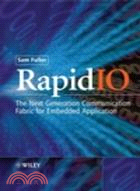| FindBook |
有 1 項符合
RAPIDIO: THE EMBEDDED SYSTEM INTERCONNECT的圖書 |
 |
RAPIDIO: THE EMBEDDED SYSTEM INTERCONNECT 作者:Fuller,Samuel H./Gatherer,Alan/Hill,Charles(CON) 出版社:John Wiley & Sons Inc 出版日期:2005-01-14 語言:英文 規格:精裝 / 360頁 / 2.5*17.1*24.1 cm / 普級 / 單色印刷 |
| 圖書館借閱 |
| 國家圖書館 | 全國圖書書目資訊網 | 國立公共資訊圖書館 | 電子書服務平台 | MetaCat 跨館整合查詢 |
| 臺北市立圖書館 | 新北市立圖書館 | 基隆市公共圖書館 | 桃園市立圖書館 | 新竹縣公共圖書館 |
| 苗栗縣立圖書館 | 臺中市立圖書館 | 彰化縣公共圖書館 | 南投縣文化局 | 雲林縣公共圖書館 |
| 嘉義縣圖書館 | 臺南市立圖書館 | 高雄市立圖書館 | 屏東縣公共圖書館 | 宜蘭縣公共圖書館 |
| 花蓮縣文化局 | 臺東縣文化處 |
|
|
- 圖書簡介
RapidIO - The Embedded System Interconnect brings together one essential volume on RapidIO interconnect technology, providing a major reference work for the evaluation and understanding of RapidIO. Covering essential aspects of the specification, it also answers most usage questions from both hardware and software engineers. It will also serve as a companion text to the specifications when developing or working with the RapidIO interconnect technology. Including the history of RapidIO and case of studies of RapidIO deployment, this really is the definitive reference guide for this new area of technology.
- 目次
Preface.
1 The Interconnect Problem.
1.1 Processor Performance and Bandwidth Growth.
1.2 Multiprocessing.
1.3 System of Systems.
1.4 Problems with Traditional Buses.
1.5 The Market Problem.
1.6 RapidIO: A New Approach.
1.7 Where Will it be Used?
1.8 An Analogy.
References.
2 RapidIO Technology.
2.1 Philosophy.
2.2 The Specification Hierarchy.
2.3 RapidIO Protocol Overview.
2.4 Packet Format.
2.5 Transaction Formats and Types.
2.6 Message Passing.
2.7 Globally Shared Memory.
2.8 Future Extensions.
2.9 Flow Control.
2.10 The Parallel Physical Layer.
2.11 The Serial Physical Layer.
2.12 Link Protocol.
2.13 Maintenance and Error Management.
2.14 Performance.
2.15 Operation Latency.
References.
3 Devices, Switches, Transactions and Operations.
3.1 Processing Element Models.
3.2 I/O Processing Element.
3.3 Switch Processing Element.
3.4 Operations and Transactions.
4 I/O Logical Operations.
4.1 Introduction.
4.2 Request Class Transactions.
4.3 Response Class Transactions.
4.4 A Sample Read Operation.
4.5 Write Operations.
4.6 Streaming Writes.
4.7 Atomic Operations.
4.8 Maintenance Operations.
4.9 Data Alignment.
5 Messaging Operations.
5.1 Introduction.
5.2 Message Transactions.
5.3 Mailbox Structures.
5.4 Outbound Mailbox Structures.
6 System Level Addressing in RapidIO Systems.
6.1 System Topology.
6.2 Switch-based Systems.
6.3 System Packet Routing.
6.4 Field Alignment and Definition.
6.5 Routing Maintenance Packets.
7 The Serial Physical Layer.
7.1 Packets.
7.2 Control Symbols.
7.3 PCS and PMA Layers.
7.4 Using the Serial Physical Layer.
7.5 Transaction and Packet Delivery Ordering Rules.
7.6 Error Detection and Recovery.
7.7 Retimers and Repeaters.
7.8 The Electrical Interface.
8 Parallel Physical Layer Protocol.
8.1 Packet Formats.
8.2 Control Symbol Formats.
8.3 Control Symbol Transmission Alignment.
8.4 Packet Start and Control Symbol Delineation.
8.5 Packet Exchange Protocol.
8.6 Field Placement and Definition.
8.7 Link Maintenance Protocol.
8.8 Packet Termination.
8.9 Packet Pacing.
8.10 Embedded Control Symbols.
8.11 Packet Alignment.
8.12 System Maintenance.
8.13 System Clocking Considerations.
8.14 Board Routing Guidelines.
9 Interoperating with PCI Technologies.
9.1 Address Map Considerations.
9.2 Transaction Flow.
9.3 PCI-X to RapidIO Transaction Flow.
9.4 RapidIO to PCI Transaction Mapping.
9.5 Operation Ordering and Transaction Delivery.
9.6 Interactions with Globally Shared Memory.
9.7 Byte Lane and Byte Enable Usage.
9.8 Error Management.
10 RapidIO Bringup and Initialization Programming.
10.1 Overview of the System Bringup Process.
10.2 System Application Programming Interfaces.
10.3 System Bringup Example.
11 Advanced Features.
11.1 System-level Flow Control.
11.2 Error Management Extensions.
11.3 Memory Coherency Support.
11.4 Multicasting Transactions in RapidIO.
11.5 Multicasting Symbols.
12 Data Streaming Logical Layer (Chuck Hill).
12.1 Introduction.
12.2 Type 9 Packet Format (Data Streaming Class).
12.3 Virtual Streams.
12.4 Configuring Data Streaming Systems.
12.5 Advanced Traffic Management.
12.6 Using Data Streaming.
13 Applications of the RapidIO Interconnect Technology.
13.1 RapidIO in Storage Systems.
13.2 RapidIO in Cellular Wireless Infrastructure (Alan Gatherer and Peter Olanders).
13.3 Fault-tolerant Systems and RapidIO (Victor Menasce).
References.
14 Developing RapidIO Hardware (Richard O’Connor).
14.1 Introduction.
14.2 Implementing a RapidIO End Point.
14.3 Supporting Functions.
14.4 Implementing a RapidIO Switch.
14.5 Summary.
15 Implementation Benefits of the RapidIO Interconnect Technology in FPGAs (Nupur Shah).
15.1 Building the Ecosystem.
15.2 Advances in FPGA Technology.
15.3 Multiprotocol Support for the Embedded Environment.
15.4 Simple Handshake.
15.5 Low Buffering Overhead.
15.6 Efficient Error Coverage.
15.7 Conclusion.
16 Application of RapidIO to Mechanical Environments (David Wickliff).
16.1 Helpful Features for Mechanical Environments.
16.2 Channel Characteristics.
16.3 Industry Standard Mechanical Platforms Supporting RapidIO.
16.4 Summary.
Appendix A: RapidIO Logical and Transport Layer Registers.
A.1 Reserved Register and Bit Behavior.
A.2 Capability Registers (CARs).
A.3 Command and Status Registers (CSRs).
A.4 Extended Features Data Structure.
Appendix B: Serial Physical Layer Registers.
B.1 Generic End Point Devices.
B.2 Generic End Point Devices: Software-assisted Error Recovery Option.
Appendix C: Parallel Physical Layer Registers.
C.1 Generic End Point Devices.
C.2 Generic End Point Devices: Software-assisted Error Recovery Option.
C.3 Switch Devices.
Appendix D: Error Management Extensions Registers.
D.1 Additions to Existing Registers.
D.2 New Error Management Register.
Index.
|











